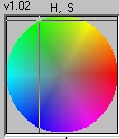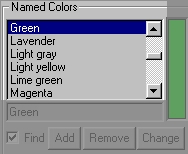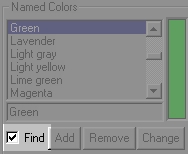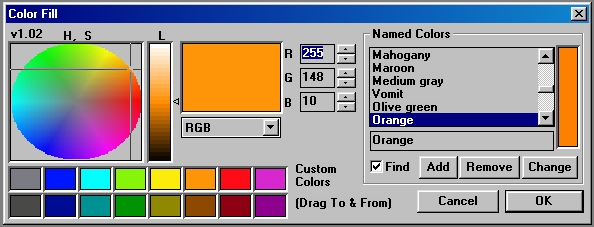§ 24 - The Color Selection Dialog
The Color Selection Dialog is used to select colors for operations that involve the use of color in creating effects or selecting areas. The dialog can be accessed by pressing a Pick Color button or by entering the Color Key controls found in the Area pull down menu. The color selection dialog is divided into two sections. The first section deals with actual color selection, and contains a Hue and Saturation Color Wheel, a Luminance Bar, a color space selector, and manual color space entry fields. These controls can be used together to create a mind boggling array of colors and hues. The second portion of the dialog allows you to maintain a group of Custom Colors and a list of Named Colors. Each of these are described below in great detail. The dialog takes full use of Drag and Drop so that you can manipulate the colors quickly and efficiently. After the desired color is in the Color Preview box, press OK to select the color for use. You can exit the dialog without selecting a color by pressing Cancel.
§ 24.1 - Controls
§ 24.1.1 - Hue and Saturation Color Wheel

The Hue and Saturation color slice allows you to select a color's Hue and Saturation values. These values are then combined with the Luminance setting (the control to the right) to create a color. The Hue and Saturation "wheel" begins with red and then moves through yellow, green, cyan, blue, magenta, and then back to red. The color is "purest" (has the most saturation) at the edge of the wheel, and as you move in towards the center of the wheel the saturation drops. The center of the wheel is a gray scale value. A color is selected by simply clicking, and holding the left mouse button on the color wheel. You can then move the mouse towards the desired color. The current color that the mouse is over will be displayed in the Color Preview Box to the right of the luminance control. Once you have the color you desire, or a lighter or darker version of the desired color, release the left mouse button. Remember, the left mouse button controls the "left color" or the beginning of any range spreads. You can place a color in the "right color" or end of the range spread by copying the desired color from the left color, and then setting the right color to the desired color. The "brightness" of the color can be altered using the Luminance control. For example, you have a Red color (R=225, G=25, B=32, and Luminance at about 50%), but it is not dark enough for the range you are creating. So, you would adjust the Luminance to about 25%, and the new red would be much darker (R=102, G=15, and B=25). You do not need to use the color wheel and luminance color to create or specify colors. You have the option of manually altering the RGB (or CMYK, HSL, etc.) values in the provided text entry fields. By doing this you can increment one or more of the components to a specific value. For more information on using the Hue and Saturation wheel, please refer to the sections below on creating spreads and ranges of colors.
§ 24.1.2 - Luminance Control
The Luminance control allows you to specify the brightness or luminosity of the color in the preview area. The Luminance is measured on a percentage scale from 0 to 100. A setting of zero will result in no luminance (black), and a setting of 100 will result in the maximum possible luminance (white). This is true regardless of the current selected color. For example, a red color can be made black by setting the Luminance control to 0 (bottom of the Luminance control), or it could be made white by setting the control to 100 (top of the Luminance control). A setting in the middle of the control (50%) will produce colors which are completely saturated or "pure colors". The luminance is set by simply clicking, and holding, the left mouse button over the luminance control. As you move the mouse, you should see the color in the preview increase or decrease in brightness as you move the mouse up and down the control. The preview will reflect all changes that you make to the luminance as they are made. When you have the desired color, release the left mouse button. The color you see in the preview will also be placed in the "left color" position.
§ 24.1.3 - Color Preview Box

The preview box contains the currently selected "left color". This color can be specified using the Hue and Saturation color wheel, or the RGB entry fields to the right of the preview. Any changes made to the color wheel, luminance control, or the RGB entry fields will be directly reflected in the preview color and the "left color" in the palette itself. This color can then be copied to the "right color" position by selecting Copy.
§ 24.1.4 - Color Spaces
This drop down box contains a wide variety of colors spaces commonly used in graphics, desktop publishing, desktop video, and NTSC video. The color spaces include RGB (red, green, blue), CMY (cyan, magenta, yellow), CMYK (cyan, magenta, yellow, black), HSL (hue, saturation, luminance), HSV (hue, saturation, value), and YIQ (luminance, chrominance). The default color space is RGB, but can be changed at any time by accessing this dialog, and double clicking on the desired color space. Once the new color space has been selected, all of the values will be recalculated to reflect the differences between the spaces. It is important to remember that F/x is dealing with pure colors, not real colors. This allows for conversion from color space to color space without altering the current "left color". The color space's letter equivalents will be placed in front of the appropriate dialog, and can be altered as described below.
§ 24.1.5 - RGB (or CMYK, CMY, HSV, HSL, YIQ)

The RGB controls allow you to enter specific Red, Green, and Blue values for the current "left color". Each of these components has two methods of entering the desired color values. The first is to simply manually enter the exact numeric values. This will alter the preview and "left color" colors. The second method is to use the up/down controls located to the left of each text entry field. These allow you to increase or decrease the desired color component by clicking on the appropriate control (up for a value increase and down for a value decrease). You should notice that there are multiple color spaces available to you. You can alter the change the current color space by following the procedure described in the above section.
§ 24.1.6 - Named Colors

The Named Colors section of the Palette dialog allows you to give names to specific RGB values. For example, the default named colors file (colorset.ini) contains such colors as Cobalt Blue and Carnation Pink. These two colors have specific RGB values, but also have a name associated with them. The controls in this portion of the dialog can be used to add additional colors and names to the colorset.clr file, remove colors from the file, or replace existing colors with new RGB values or names. A named color is placed into the palette and preview color box by simply selecting the desired named color, and then clicking on the named color preview color box to the right of the list. This will automatically place the named color into the left color position of the palette, and will adjust the RGB values accordingly. The intent of the named colors are to allow you to specifically name colors that you use frequently. This means that you no longer have to remember an obscure RGB value, but can instead remember a name which describes the color in question. The Named Color section of this palette dialog can be particularly useful for operations like Color Fill or Colorize.
All of the Named Colors are kept in an ASCII text file called colorset.ini located in your Windows directory. You can use any Text Editor to add new named colors to the file. You may find this method to be faster if you are entering multiple colors and names. The instructions at the top of the file describe the method for adding new colors to the list. Once you have added the desired colors and names save the file and exit the text editor. The next time that you open the palette the new named colors will be available. Remember, the named colors file (colorset.ini) is used for both the palette and the Pick Color selection dialog. This is not the only method of adding colors to the named colors list. Named colors can be added to the list in both the palette and color selector by pressing Add. Its use is described below in the Add documentation.
§ 24.1.7 - Find

The Find control, when selected, will force F/x to find the color in the named colors list that is closest to the current color in the Preview Color box. For example, if you were selecting a color with the Hue and Saturation color wheel, you would see the current named color shift from name to name (color to color) as you move the mouse pointer over the color wheel. Remember, this is the closest color in the named color list. The current preview color can be added to the named color list by entering a new name, and then pressing Add. This will add the color to the list with the specified name and color space values (RGB, CMYK, HSL, etc.). If the find control is not selected, the current name color will only change when a new color is specified or selected using the provided list requester.
§ 24.1.8 - Add
AddThe Add control is used to add new colors to the named colors list. New colors area added to the list by selecting the desired color, entering a name for the color, and then pressing Add. The color can be selected with the Hue and Saturation color wheel, or by the manual RGB numeric entry fields to the right of the color wheel. After the color is set, enter an appropriate name for the color. F/x will place the color directly above the currently highlighted named color. F/x will not automatically alphabetize the new named color entry. If you would like the list to remain alphabetical, you will need to manually select the appropriate location for the new named color. After you have the color set, named, and ready to go into the desired position in the list, press Add. This will automatically place the new name and color into the list, and make it the current named color. Remember, clicking on the named color preview box (to the right of the name list) will place the color in the current left color position as well as alter the RGB values to their appropriate settings.
§ 24.1.9 - Remove
RemoveThis control is used to remove colors which are no longer needed. The remove control works by simply selecting the color to remove, and then pressing Remove. Once a color is removed from the list it will not appear again unless the color is re-added at a latter time. The remove feature can also be used to remove newly added colors that are in the wrong position in the list. You also have the option of Changing the color instead of removing it.
§ 24.1.10 - Change
ChangeThe Change control is used to change the name or RGB values of the currently selected named color. You have the option to change the name, the color, or both. The first step in changing a named color is to select the color to be changed. If you are going to change the name, but not the color, you must first click on the named color preview color box to the right of the names list. This will place the current named color into the palette color preview. Next, enter the change to be made to the name, and press Change. This will replace the old name with the new name, but will not alter the actual color. If you would like to change only the color, do not click on the named color preview color. Instead, alter the color using the Hue and Saturation color wheel, or the manual RGB entry fields. After you have the desired color in the palette color preview , press Change. You can follow the same procedures to change the name and color. The only difference is that after setting the color you will also need to alter the name. Once that is complete, you can select Change to alter the color and color name. The changes made to the named colors list will be saved colorset.ini file when the palette is closed.
§ 24.1.11 - OK
This will close the Palette dialog, and will allow you to use any modifications made to the palette. Remember, the last palette that is visible before closing will be used for all Fill operations, and can be used as the output palette if that option is selected. Once the Set Color Dialog is closed, you can always reopen it by selecting Set Color on one of the Fill operation dialogs.
, Previous Page . Next Page t TOC i Index o Operators g Glossary
Copyright © 1992-2007 Black Belt Systems ALL RIGHTS RESERVED Under the Pan-American Conventions
WinImages F/x Manual Version 7, Revision 6, Level A
